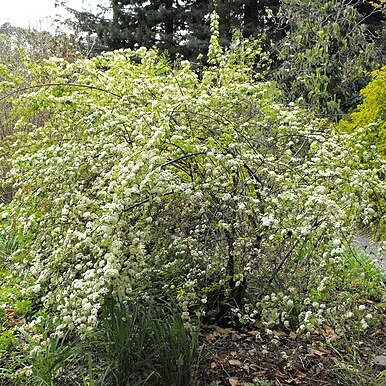Shrubs 1–2 m tall. Branchlets spreading, dark red-brown or dark gray-brown, slender, glabrous; buds ovoid, small, with several scales, glabrous, apex acute or obtuse. Petiole 2–4 mm, glabrous; leaf blade bluish green abaxially, rhombic-ovate to obovate or broadly ovate, (0.6–0.9 or)2–3.5 × 1–1.8 cm, glabrous on both surfaces, inconspicuously 3-veined or pinnately veined, base cuneate, margin remotely obtusely incised crenate or 3–5-lobed above middle, apex obtuse or mucronate. Umbels pedunculate, 10–25-flowered; rachis glabrous; pedicels 6–10 mm, glabrous to puberulous; bracts lanceolate, 1–3 mm, glabrous. Flowers 5–8 mm in diam. Hypanthium shallowly campanulate, glabrous to puberulous abaxially. Sepals triangular or ovate-triangular, 1.5–2.5 mm, erect in fruit, apex acute or shortly acuminate. Petals white, broadly obovate, 2–5 mm, about as broad as long, apex emarginate. Stamens 18–20, shorter than petals. Disk annular, 10-lobed; lobes thin, apex emarginate. Carpels glabrous, puberulous only on adaxial suture, or pubescent; styles shorter than stamens. Follicles erect, glabrous or pubescent; styles abaxial, divergent. Fl. Apr–Jun, fr. Aug–Oct.
More
A shrub. It loses its leaves during the year. It grows 1 m high. The leaves are alternate. They are often in clusters and broadly oval. They are 2-4 cm long by 1-2 cm wide. The base is wedge shaped. There are 3 to 5 shallow lobes. The flowers are white. They are 3-8 mm across. They are on short shoots near the ends of branches.
Thickets and ravines; at elevations from 600-2,000 metres in W. Hupeh. Mixed forests, slopes, limestone mountain valleys, stream sides, roadsides; at elevations from 500-2,000 metres.
More
It is a subtropical plant. It is native to eastern Asia. It grows in limestone mountains. It grows on sunny slopes. In north China it grows between 500-2,000 m above sea level.

